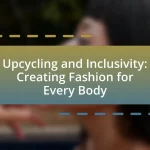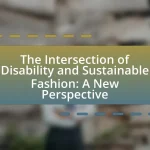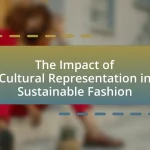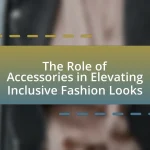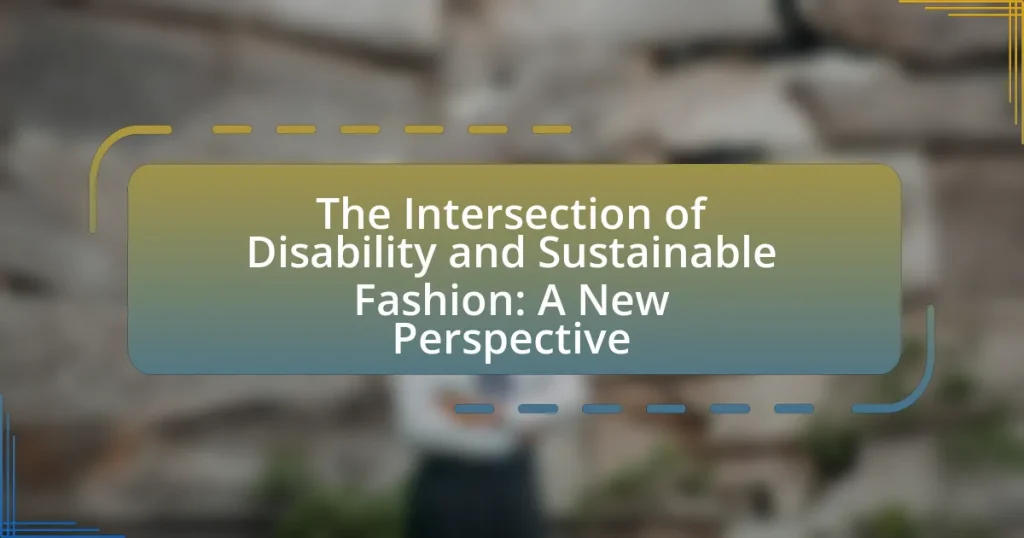Fashion icons play a crucial role in redefining cultural representation within the fashion industry by influencing societal norms and values through their unique styles and public personas. This article explores how figures like Rihanna and André Leon Talley challenge traditional beauty standards, promote inclusivity, and reflect diverse cultural narratives. It examines the impact of these icons on cultural discourse, the importance of representation for underrepresented communities, and the challenges they face, including cultural appropriation and societal expectations. Additionally, the article highlights strategies for promoting inclusivity and authentic representation in fashion, emphasizing the significance of collaboration and cultural advocacy.
![]()
What defines a fashion icon in cultural representation?
A fashion icon in cultural representation is defined by their ability to influence societal norms and values through their distinctive style and public persona. This influence is often rooted in their capacity to challenge traditional fashion boundaries, promote diversity, and reflect cultural narratives. For instance, figures like Rihanna and André Leon Talley have redefined beauty standards and representation in fashion, showcasing how personal identity can shape cultural discourse. Their impact is evidenced by their roles in major fashion events and collaborations that emphasize inclusivity, thereby altering the landscape of fashion to be more representative of various cultures and identities.
How do fashion icons influence cultural narratives?
Fashion icons influence cultural narratives by shaping societal perceptions of identity, beauty, and self-expression through their style choices and public personas. For instance, figures like Audrey Hepburn and Rihanna have not only set trends but also challenged traditional norms, promoting inclusivity and diversity in fashion. Hepburn’s classic elegance redefined femininity in the mid-20th century, while Rihanna’s bold fashion statements and advocacy for body positivity have transformed contemporary views on beauty standards. These icons serve as cultural touchstones, reflecting and often leading shifts in public attitudes and values, thereby embedding their influence into the broader cultural narrative.
What role do fashion icons play in shaping societal norms?
Fashion icons play a significant role in shaping societal norms by influencing public perceptions of beauty, identity, and self-expression. Their choices in clothing, accessories, and overall style often set trends that reflect and sometimes challenge cultural values. For instance, figures like Audrey Hepburn and Rihanna have not only popularized specific fashion styles but have also redefined femininity and body image standards, impacting how society views these concepts. Research indicates that the visibility of diverse fashion icons can lead to greater acceptance of different body types and cultural backgrounds, as seen in the rise of plus-size models and the celebration of multicultural aesthetics in mainstream fashion.
How do they challenge stereotypes through their style?
Fashion icons challenge stereotypes through their style by embracing and showcasing diverse cultural elements that defy conventional norms. For instance, designers like Virgil Abloh and models such as Adwoa Aboah incorporate traditional patterns, colors, and silhouettes from their heritage into contemporary fashion, thereby promoting inclusivity. This approach not only highlights the richness of various cultures but also disrupts the mainstream narrative that often marginalizes these identities. By doing so, they create a dialogue around representation and authenticity, encouraging others to celebrate their backgrounds rather than conform to a singular aesthetic.
Why is cultural representation important in fashion?
Cultural representation is important in fashion because it fosters inclusivity and reflects the diversity of society. When fashion incorporates various cultural elements, it validates and honors different identities, allowing individuals to see themselves represented in mainstream narratives. For instance, the rise of diverse models on runways and in advertising campaigns has been shown to positively impact self-esteem and body image among underrepresented groups, as evidenced by studies from the University of California, which found that representation in media can significantly influence personal perceptions of beauty and worth. Thus, cultural representation in fashion not only enriches the industry but also promotes social acceptance and understanding.
What impact does representation have on diverse communities?
Representation significantly impacts diverse communities by fostering inclusivity and validating identities. When individuals from various backgrounds see themselves reflected in media, fashion, and leadership, it enhances their sense of belonging and self-worth. Studies indicate that representation can lead to increased participation in cultural and social activities, as well as improved mental health outcomes. For instance, a report by the Geena Davis Institute on Gender in Media highlights that diverse representation in film and television correlates with greater acceptance and understanding of different cultures among audiences. This demonstrates that representation not only empowers individuals but also promotes social cohesion within diverse communities.
How does fashion serve as a platform for cultural expression?
Fashion serves as a platform for cultural expression by allowing individuals and communities to showcase their identities, values, and heritage through clothing and style choices. This is evident in the way traditional garments, such as the kimono in Japan or the sari in India, are worn not only for cultural significance but also as a statement of pride and identity in contemporary settings. Additionally, fashion designers often draw inspiration from their cultural backgrounds, creating collections that reflect their heritage, such as the work of African designers who incorporate traditional patterns and textiles into modern fashion. This blending of cultural elements in fashion not only promotes diversity but also fosters dialogue about cultural appreciation and representation in the global fashion industry.
![]()
Who are some notable fashion icons redefining cultural representation?
Notable fashion icons redefining cultural representation include Rihanna, who has significantly influenced the beauty and fashion industries with her inclusive Fenty Beauty line, which offers a wide range of shades for diverse skin tones. Another key figure is Virgil Abloh, the late designer who served as the artistic director of Louis Vuitton’s menswear and founded Off-White, promoting streetwear and challenging traditional fashion norms. Additionally, models like Adwoa Aboah and Halima Aden have brought attention to issues of representation and diversity in modeling, advocating for greater visibility of underrepresented communities. These individuals have not only made impactful contributions to fashion but have also sparked broader conversations about identity and inclusivity within the industry.
What characteristics make these individuals stand out?
Fashion icons who redefine cultural representation stand out due to their unique ability to blend personal style with cultural significance. These individuals often challenge societal norms and stereotypes through their fashion choices, using clothing as a medium for self-expression and cultural storytelling. For instance, designers like Virgil Abloh and models like Adwoa Aboah incorporate elements from their heritage into contemporary fashion, thereby promoting diversity and inclusivity. Their influence is evidenced by the increasing visibility of diverse representations on runways and in media, which has been shown to inspire a broader acceptance of different cultural identities within the fashion industry.
How do their backgrounds influence their fashion choices?
Individuals’ backgrounds significantly influence their fashion choices by shaping their cultural identity, socioeconomic status, and personal experiences. Cultural heritage often dictates traditional attire, color preferences, and styles that resonate with one’s community, as seen in the use of vibrant patterns in African fashion or the incorporation of indigenous motifs in Native American clothing. Socioeconomic factors also play a crucial role; for instance, access to luxury brands or sustainable fashion varies widely, impacting choices and expressions of personal style. Additionally, personal experiences, such as migration or exposure to diverse cultures, can lead to eclectic fashion preferences that blend various influences, exemplified by figures like Rihanna, who merges Caribbean roots with high fashion. These elements collectively create a unique fashion narrative that reflects individual backgrounds and cultural representation.
What messages do they convey through their public personas?
Fashion icons who redefine cultural representation convey messages of inclusivity, empowerment, and authenticity through their public personas. These individuals often challenge traditional beauty standards and promote diversity by showcasing various cultural backgrounds and body types in their fashion choices. For instance, models like Adwoa Aboah and Halima Aden have used their platforms to advocate for mental health awareness and the representation of Muslim women in fashion, respectively. Their visibility and advocacy highlight the importance of embracing one’s identity and breaking down societal barriers, thus inspiring others to celebrate their uniqueness.
How have these icons impacted the fashion industry?
Fashion icons have significantly impacted the fashion industry by challenging traditional norms and promoting diversity. These individuals have redefined beauty standards, leading to a broader representation of different cultures and body types in fashion campaigns and runway shows. For instance, models like Naomi Campbell and Tyra Banks broke racial barriers in the 1990s, paving the way for greater inclusivity. Additionally, designers such as Virgil Abloh and Rihanna have infused cultural elements into high fashion, influencing mainstream trends and encouraging brands to embrace multicultural aesthetics. This shift has resulted in increased visibility for underrepresented groups, ultimately transforming consumer expectations and industry practices.
What changes have occurred in fashion marketing due to their influence?
Fashion marketing has undergone significant changes due to the influence of fashion icons who redefine cultural representation. These icons have shifted marketing strategies towards inclusivity and diversity, emphasizing representation of various ethnicities, body types, and gender identities. For instance, brands like Savage X Fenty, led by Rihanna, have successfully integrated diverse models in their campaigns, resulting in a reported 30% increase in sales after their inclusive runway shows. This shift reflects a broader trend where consumers increasingly demand authenticity and relatability in brand messaging, leading to a more personalized and community-focused approach in fashion marketing.
How have they inspired new trends that reflect cultural diversity?
Fashion icons have inspired new trends that reflect cultural diversity by incorporating elements from various cultures into mainstream fashion. For instance, designers like Virgil Abloh and Rihanna have blended traditional African patterns and motifs with contemporary styles, showcasing the richness of cultural heritage. This fusion not only promotes inclusivity but also encourages consumers to embrace diverse cultural narratives, as seen in the rise of streetwear that celebrates global influences. The impact is evident in fashion weeks worldwide, where collections increasingly feature multicultural themes, highlighting the importance of representation in the industry.
![]()
What challenges do fashion icons face in cultural representation?
Fashion icons face significant challenges in cultural representation, primarily due to the risk of cultural appropriation and the pressure to conform to mainstream beauty standards. Cultural appropriation occurs when elements of a marginalized culture are used without understanding or respect, often leading to backlash against the fashion icon for misrepresenting or commodifying that culture. Additionally, fashion icons often struggle to balance authenticity with commercial viability, as they may be pressured to adopt looks that align with dominant cultural narratives rather than their own heritage. This tension can dilute their cultural identity and lead to criticism from both their community and the broader public. For instance, the backlash faced by certain celebrities for wearing traditional garments inappropriately highlights the delicate nature of cultural representation in fashion.
How do societal expectations affect their representation?
Societal expectations significantly shape the representation of fashion icons by dictating the standards of beauty, style, and identity that are deemed acceptable or desirable. These expectations often lead to the promotion of specific body types, ethnicities, and gender expressions, which can marginalize those who do not conform. For instance, the fashion industry has historically favored thin, Eurocentric models, reflecting societal biases that prioritize certain aesthetics over diversity. This has been evidenced by studies showing that diverse representation in media can positively influence public perception and acceptance of different cultures and body types, as seen in campaigns by brands like Savage X Fenty, which actively challenge traditional norms and promote inclusivity.
What barriers exist for underrepresented groups in fashion?
Underrepresented groups in fashion face barriers such as systemic discrimination, lack of access to resources, and limited representation in decision-making roles. Systemic discrimination manifests through biased hiring practices and cultural stereotypes that hinder opportunities for individuals from diverse backgrounds. Additionally, underrepresented groups often lack access to financial resources, mentorship, and networks that are crucial for success in the industry. A study by the Council of Fashion Designers of America (CFDA) in 2020 highlighted that only 27% of fashion designers identified as people of color, indicating a significant gap in representation and opportunity. These barriers collectively contribute to the ongoing challenges faced by underrepresented groups in achieving equity within the fashion industry.
How do fashion icons navigate criticism and backlash?
Fashion icons navigate criticism and backlash by employing strategies such as maintaining authenticity, leveraging social media, and engaging with their audience. For instance, many fashion icons respond to negative feedback by staying true to their personal style and values, which reinforces their brand identity. Additionally, they utilize platforms like Instagram and Twitter to communicate directly with fans, clarify misconceptions, and share their perspectives, effectively controlling the narrative around their image. Research indicates that public figures who engage transparently with their audience can mitigate backlash; a study published in the Journal of Communication found that authenticity in communication fosters trust and loyalty among followers.
What strategies can fashion icons use to promote inclusivity?
Fashion icons can promote inclusivity by actively showcasing diverse body types, ethnicities, and gender identities in their campaigns and collaborations. By partnering with models and designers from underrepresented communities, they can challenge traditional beauty standards and foster a more inclusive fashion narrative. For instance, brands like Savage X Fenty, led by Rihanna, have successfully integrated a wide range of sizes and ethnicities in their runway shows, demonstrating that inclusivity can drive both social change and commercial success. This approach not only broadens representation but also resonates with a wider audience, ultimately enhancing brand loyalty and market reach.
How can they leverage social media for cultural advocacy?
Fashion icons can leverage social media for cultural advocacy by using their platforms to promote diverse cultural narratives and engage with their audiences on issues of representation. By sharing personal stories, showcasing traditional attire, and collaborating with cultural organizations, they can raise awareness and foster dialogue around cultural identity. For instance, research indicates that social media campaigns featuring authentic cultural representation can increase visibility and support for marginalized communities, as seen in the #BlackLivesMatter movement, which utilized platforms like Instagram and Twitter to amplify voices and advocate for social change.
What collaborations can enhance cultural representation in fashion?
Collaborations between fashion brands and diverse cultural artists can significantly enhance cultural representation in fashion. For instance, partnerships with indigenous designers or local artisans can bring authentic cultural narratives and craftsmanship into mainstream fashion. A notable example is the collaboration between Nike and the designer Amina Muaddi, which highlighted Middle Eastern aesthetics and craftsmanship, showcasing cultural diversity in a global brand. Such collaborations not only promote inclusivity but also educate consumers about different cultural heritages, fostering a deeper appreciation for diversity in fashion.
What can emerging fashion icons learn from established figures?
Emerging fashion icons can learn the importance of authenticity and cultural representation from established figures. Established icons, such as Naomi Campbell and Rihanna, have successfully navigated the fashion industry by embracing their unique identities and backgrounds, which has resonated with diverse audiences. For instance, Naomi Campbell’s career has highlighted the significance of representation for Black models, while Rihanna’s Fenty Beauty line has set a precedent for inclusivity in beauty standards. These examples demonstrate that emerging icons can build their brands by staying true to their cultural narratives and advocating for diversity, ultimately fostering a more inclusive fashion landscape.
How can they build their brand while staying true to their cultural roots?
They can build their brand while staying true to their cultural roots by integrating authentic cultural elements into their designs and marketing strategies. This approach not only honors their heritage but also resonates with consumers seeking genuine representation. For instance, brands like Pyer Moss incorporate African American history and storytelling into their collections, which has garnered significant attention and respect within the fashion industry. By collaborating with local artisans and using traditional techniques, they reinforce cultural authenticity while appealing to a broader audience. This strategy has been shown to enhance brand loyalty and consumer trust, as evidenced by the increasing demand for culturally inspired fashion that reflects diverse backgrounds.
What best practices should they follow to ensure authentic representation?
To ensure authentic representation, fashion icons should prioritize inclusivity by collaborating with diverse voices from various cultural backgrounds. This practice not only amplifies underrepresented perspectives but also fosters a more genuine portrayal of cultural narratives. For instance, brands that have successfully integrated diverse designers and models, such as Savage X Fenty, have demonstrated that authentic representation can lead to increased consumer engagement and brand loyalty. Research indicates that 67% of consumers are more likely to purchase from brands that reflect their values, highlighting the importance of authentic representation in driving business success.
